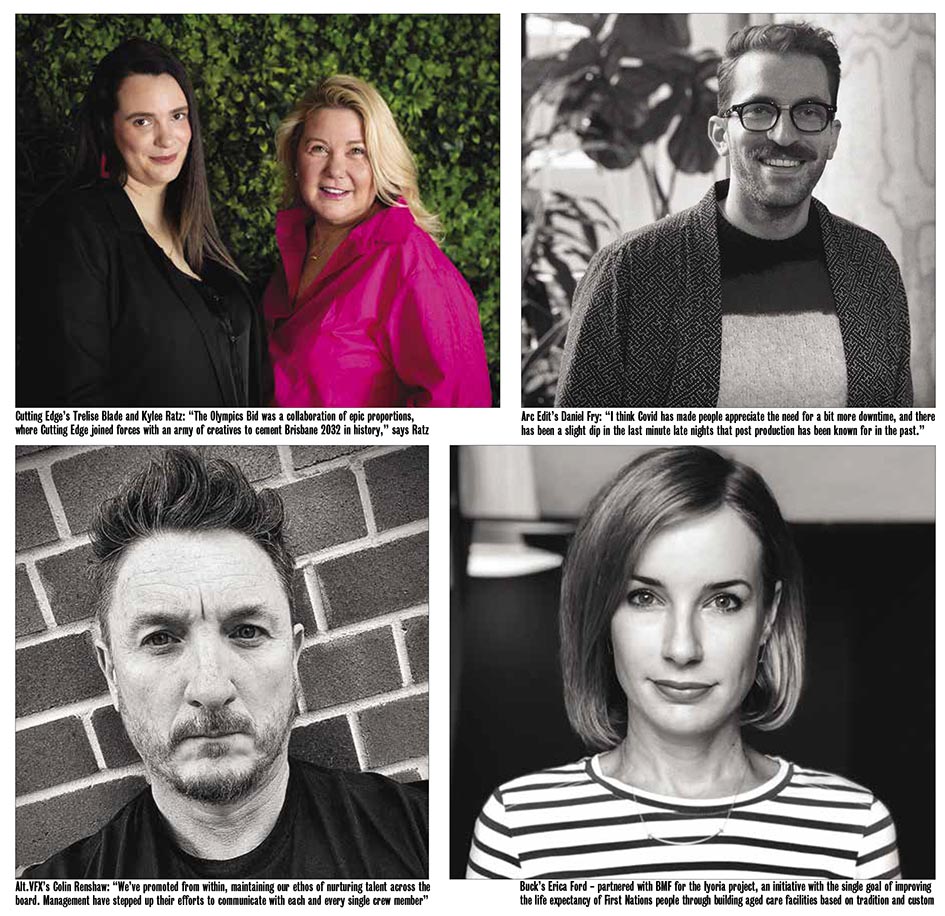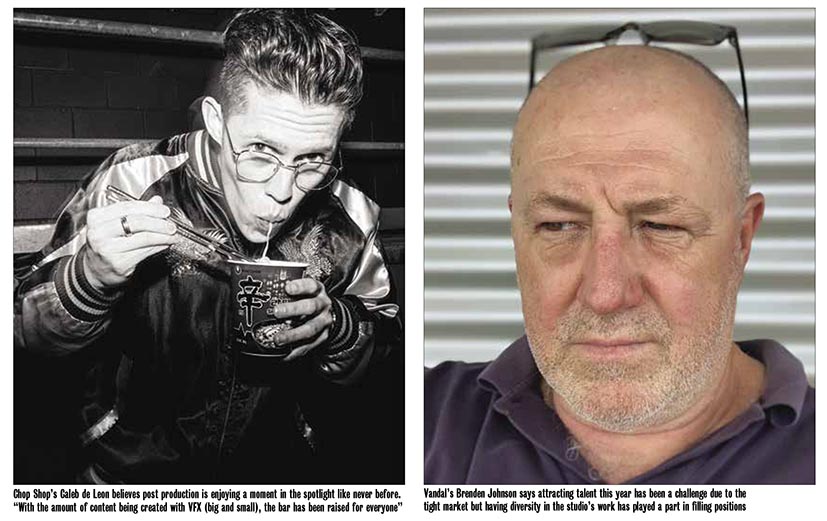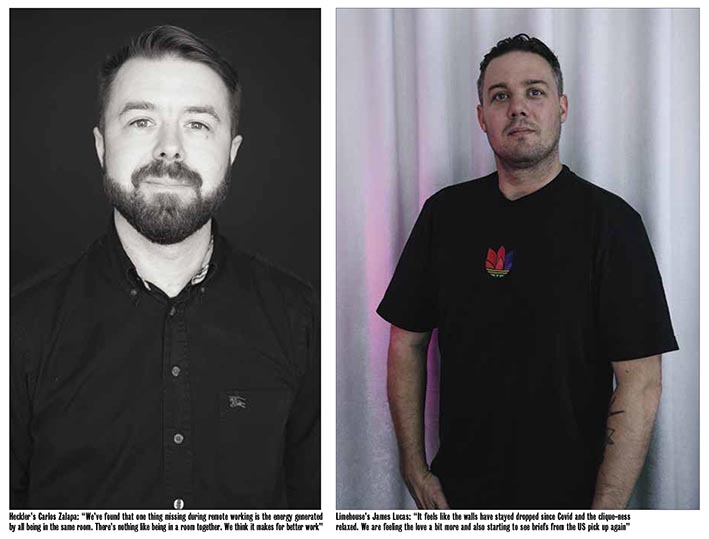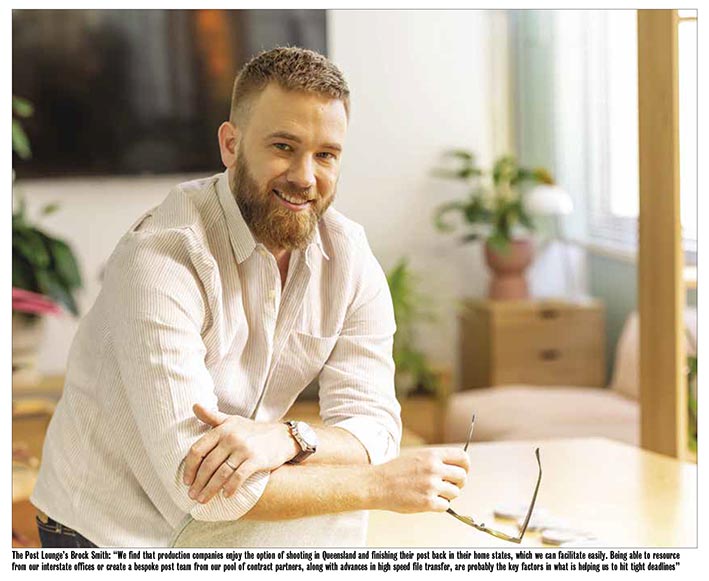POST PRODUCTION: STATE OF THE INDUSTRY 2022

Ongoing border restrictions and forced lockdowns have seen the country’s leading post production companies continue to pivot their approach to delivering creative solutions, finding innovative and creative ways to get around the challenges of working through a global pandemic. Campaign Brief zooms in for a closer look…
It’s been a busy year for episodic and feature work and Alt.vfx executive director Tyrone Estephan says the studio has leaned into that side of the business. Traditionally Altvfx’s core business is commercials and the studio took on TVC work out of APAC, with Japan and the US proving strong markets.
Says Estephan: “It feels like the international ideas, budgets and schedules are bigger and more realistic compared to what we see from the local market.”
Often he says these global campaigns require expertise across character design, CGI creatures and emerging technology.
Arc Edit executive producer Daniel Fry says whilst the vast majority of his studio’s work has been Australian-based, international directors are slowly re-appearing on our shores. “We definitely aren’t anywhere near the level of international work we were seeing in late 2020 and early 2021, when Australia was the safest and easiest place in the world to shoot,” he says, adding: “I haven’t been seeing any more time crunch in the past year. If anything, I think Covid has made people appreciate the need for a bit more downtime, and there has been a slight dip in the last minute late nights that post production has been known for in the past.”
Buck executive producer Erica Ford says briefs have been skewed a little towards local work this year, but she is still seeing lots of international work coming through.“There has definitely been an influx of 3D scripts this year and we’ve continued to build out the entire team.”
With studios based in Brisbane, Sydney and Melbourne, The Post Lounge has seen equal interest across the states. Says The Post Lounge senior producer Brock Smith: “We find that production companies enjoy the option of shooting in Queensland and finishing their post production back in their home states, which we can facilitate easily. Being able to resource from our interstate offices or create a bespoke post team from our pool of contract partners, along with keeping up with the advances in high speed file transfer and remote collaboration, are probably the key factors in what is helping us to hit tight deadlines.”
Cutting Edge has also worked on a plethora of local Brisbane campaigns and some great work out of Melbourne, along with some overseas-based jobs for Netflix.
Turning 30 this year and reinventing its entire design and effects team, Cutting Edge is excited to share Squeak with the world.
Says Cutting Edge general manager Kylee Ratz: “Lovers of design and animation, keep an eye out for what the guys are up to!”
After two years of Covid, Ratz didn’t imagine 2022 would kick off with too many issues, however Mother Nature had other ideas presenting the challenge of flood recovery. The entire ground floor of the Brisbane studio was decimated and had to be completely gutted. Despite the heart-breaking outcomes, the Cutting Edge team, alongside some of its clients, came together and performed an outstanding clean-up effort.
“With minimal downtime, we were back up and running in what could only be described as construction chic. We honestly are so grateful for our clients for looking past the not-so-lush surroundings and allowing our talented team to do what they do best and continue to deliver outstanding creative.”
Historically locally focused, this year the majority of work for Chop Shop Post came out of Brisbane and the studio also worked on some high-end brand campaigns out of Asia.
Chop Shop Post creative director and VFX supervisor Caleb De Leon believes post production is enjoying a moment in the spotlight like never before.
“With the amount of content being created with VFX (big and small), the bar has been raised for everyone,” he says, adding: “I think that people are expecting more innovation and are becoming more educated to be able to see behind some of the old post-production magic tricks. I think the ultimate challenge is how do we continue to create exciting work and deliver more for less now that the bar has been raised.”
With a few interstate and overseas projects coming in, local also seems to be the main centre of attention for Vandal. Vandal managing director Brenden Johnson says: “Working on the new branding of NITV was one that we’d highlight, the new branding includes a redesigned NITV logo which incorporates the Bilma —the North-East Arnhem land term for ‘clapstick’— and the SBS Mercator symbol. As the clapsticks are struck, the rhythm, represented by Songlines, is carried across the country, connecting and celebrating Indigenous cultures. The new brand incorporates a colour palette inspired by the natural world that highlights four defining countries. Running left to right, the four clapsticks represent Saltwater, Freshwater, Bush Country and Desert Country mobs respectively. We worked with composer William Barton at Little Street Studio to compose the musical identity.”
Johnson says attracting talent this year has been a challenge due to the tight market but having diversity in the studio’s work has played a part in filling positions.

Limehouse has seen the vast majority of its work from Sydney based clients. However, it has welcomed work from both Melbourne and Singapore. Says Limehouse creative director and partner James Lucas: “It feels like the walls have stayed dropped since Covid and the clique-ness relaxed, with more openness to work wider. We are feeling the love a bit more and also just starting to see briefs from the US pick up again.”
Lucas believes some of the challenges continue to be attracting talent and getting everyone back into the studio safely. “Meeting people, both new and old, and showing work, sharing ides and connecting has proved hard. Our regular Creative Circle events (with Campaign Brief) launched and might go some way to kick-starting this, and has got a lot of support from others wanting to get involved, which is always positive.”
It seems many brands are basing their APAC headquarters in Singapore and this works in Heckler’s favour as the company’s production footprint extends across APAC with studios based in Singapore and Sydney.
While Heckler works with a global pool of staff and freelance talent, Jamie Watson, one of Heckler’s founders, has recently taken on the role of ECD and oversees all creative output. Although Heckler executive producer Carlos Zalapa is proud of the company’s roster of freelance talent, he believes nothing compares to working in a room together.
“We pride ourselves on a great in-house experience and the atmosphere that the iconic Paramount House building provides. We’ve found that one thing missing during remote working is the energy generated by all being in the same room. There’s nothing like being in a room together. We think it makes for better work.”
Talent on Top
This year many post production companies are seeing an increase in demand for compositing roles. De Leon at Chop Shop Post says as a big wave of long-form projects hit Australian shores, the demand for editors of all levels and some confident compositors are at an all-time high. He adds: “We’re pretty discerning with the kinds of jobs that we choose to do, so it’s never too hard to tantalise and attract amazing artists and editors when a project requires.”
Alt.vfx Group director and founder Col Renshaw agrees: “Compositing roles have become more in demand over the past year. No matter what the content (and there is heaps of it being made now in Australia), the difference between a good and bad shot can come down to the compositor at the end of the pipeline. Someone who can understand the photographic language of a project and can adapt to multiple styles is a rare find.”
He acknowledges one of the biggest challenges is finding talent. “Australia is currently experiencing a boom time in production, and with that, the demand for talent is huge. In normal times, the larger post studios would have flown in talent from all across the globe, but Covid-19 has changed the industry in that respect, with a lot more hybrid/remote workers and large multinational companies coming onshore and soaking up any available resource, even cannibalising the crew of other companies.”
This year Alt.vfx has focused on its crew, putting faith and resources into their wellbeing and development. Says Renshaw: “We’ve promoted from within, maintaining our ethos of nurturing talent across the board. Management have stepped up their efforts to communicate with each and every single crew member regularly and help them achieve their goals. New Holland Creative has engaged more talented, gender-diverse designers which has brought a more powerful, inclusive design aesthetic to the team’s repertoire and the work created.”

Over at Vandal, Johnson says it’s been fairly consistent acorss all sectors of business but the biggest increase in demand has been in design and experiential. He also admits obtaining 3D artists has been difficult this year.
The post industry is short on talent acorss the board, however Fry at Arc Edit says there are two areas where he is feeling the pinch most and that is finding assistant editors and colourists. He says: “Both are in such high demand at the moment, especially with the huge increase in demand from feature film work.”
This year Arc Edit has added a good number of new talent to its roster, turning to overseas and younger up-and-coming talent to fill the gap left by its senior roster diversifying more into long-form projects. Says Fry: “A special mention definetly goes out to Phoebe Taylor, who has worked her way up through the ranks as an assistant editor and has built an incredibly varied and cinematic reel in a very short time of space. Phoebe represents a new wave of younger female-led talent that is really pushing editing in exciting new directions at the moment.”
This year, he says, has been one of the busiest in recent memory meaning the biggest challenge has been a lack of quality resources to match the workload.
“There just simply aren’t enough people out there to handle the volume of work, from technical and creative assistants through to editors, VFX artists and colourists. We need to make sure we as an industry are nurturing and empowering younger talent to step up to solve this issue for the future.”
Working across both production and post, Limehouse requires staff with a broad knowledge base across a number of techiniques, along with a deep domain knowledge in one area of expertise. Lucas says Australia needs more overseas talent, especailly with the big animation and VFX studios opening and pulling in a great number of the freelance CGI artists to film productions.
He also thinks producers are in demand but less available, especially since during the pandemic many freelancers looked for the stability of a full time role.

Witnessing an increase in clients wanting to come back into the studio, Smith at The Post Lounge says the client service team has been extra busy.
“I’m finding that while we have a wonderful core crew of commercial staff, we are also enjoying working with our clients to create bespoke teams with our trusted contractors to best service each campaign.”
Reel Highlights
Working on a stack of great creative this year, Buck was briefed on a handful of well-funded projects allowing the team to take on more work creating positive social change. Notably, the studio partnered with BMF for the Iyoria project – an initiative with the single goal of improving the life expectancy of First Nations people through building aged care facilities based on tradition and custom. Buck also continued its ongoing partnerships with Union and TBWA Melbourne, working on some scripts for Bankwest and Seek.
Telstra Smart Modem was a clear standout for Heckler this year. The studio collaborated with Tim Main at Revolver, while being creatively directed by Stuart Alexander at The Monkeys. Led by Adrien Girault, the team crafted a dynamic visualization of the Telstra Smart Wifi using the latest Houdini particle FX technology.
Standouts for Limehouse included the FX and post production on a campaign for Colgate out of Singapore. Another was a TVC for Zambrero, which saw the post shop work with director Toby Morris. Says Lucas: “Together we nailed quirky and dry humour on a budget and dealt with severe weather on a night time shoot!” Lastly, creative CGI print, and animation for Miller Chill and similar CGI, animation and retouching work for Qantas, Optus and Moccona delivered some simple but crafted ads that went everywhere.
Read the full article and more in the latest print edition of Campaign Brief, out this week…


2 Comments
I did a double take on Brock from The Post Lounge, cuz I thought it was me.
Dear Campaign Brief.
Can I suggest on your next Post expose you include some freelancers, not just Post houses.
They represent a very large proportion of the Post Industry.